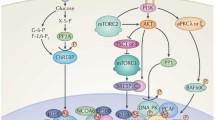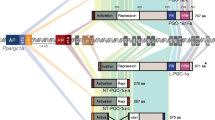Abstract
The acyl-CoA binding protein (ACBP) is a 10 kD intracellular lipid binding protein that binds and transports acyl-CoA esters. The protein is expressed in most cell types at low levels; however, expression differs markedly between different cell types with expression being particularly high in e.g. cells with a high turnover of fatty acids. We show here that the relatively high basal promoter activity of the rat ACBP gene in fibroblasts and hepatoma cells relies on sequences between −331 to −182 and on the Sp1 and NF-Y sites at −172 and −143, respectively. The basal transcription is modulated by members of the PPAR and SREBP families. In adipocytes, PPARγ is in part responsible for the induction during adipocyte differentiation, but other transcription factors appear to play a role as well. In hepatocytes, SREBP-1c is the main regulator of ACBP in response to changes in insulin levels during fasting/refeeding. PPARα counteracts this effect by stimulating ACBP expression during fasting. In addition, PPARα mediates the induction of ACBP expression in response to peroxisome proliferators. PPARα and PPARγ do not require sequences upstream of −182 for transactivation; however, SREBP-1c requires the synergistic action of sequences in intron 1 for transactivation of the ACBP promoter.
Similar content being viewed by others
References
Kragelund BB, Knudsen J, Poulsen FM: Acyl-coenzyme A binding protein (ACBP). Biochim Biophys Acta 1441: 150–161, 1999
Mandrup S, Fæ rgeman NJ, Knudsen J: Structure, function, and phylogeny of acyl-CoA binding protein. In Cellular proteins and their fatty acids in health and disease. Duttaroy AK and Spener F, editors. WILEY-VCH Verlag GmbH and Co. KGaA, Weinheim. 151–189, 2003
Mandrup S, Hummel R, Ravn S, Jensen G, Andreasen PH, Gregersen N, Knudsen J, Kristiansen K: Acyl-CoA-binding protein/diazepam-binding inhibitor gene and pseudogenes. A typical housekeeping gene family. J Mol Biol 228: 1011–1022, 1992
Rasmussen JT, Rosendal J, Knudsen J: Interaction of acyl-CoA binding protein (ACBP) on processes for which acyl-CoA is a substrate, product or inhibitor. Biochem J 292: 907–913, 1993
Kerkhoff C, Beuck M, Threige RJ, Spener F, Knudsen J, Schmitz G: Acyl-CoA binding protein (ACBP) regulates acyl-CoA: cholesterol acyltransferase (ACAT) in human mononuclear phagocytes. Biochim.Biophys. Acta 1346: 163–172, 1997
Rasmussen JT, Faergeman NJ, Kristiansen K, Knudsen J: Acyl-CoA-binding protein (ACBP) can mediate intermembrane acyl-CoA transport and donate acyl-CoA for beta-oxidation and glycerolipid synthesis. Biochem J 299: 165–170, 1994
Bhuiyan AK, Pande SV: Carnitine palmitoyltransferase activities: effects of serum albumin, acyl-CoA binding protein and fatty acid binding protein. Mol Cell Biochem 139: 109–116, 1994
Bhuiyan J, Pritchard PH, Pande SV, Seccombe DW: Effects of high-fat diet and fasting on levels of acyl-coenzyme A binding protein in liver, kidney, and heart of rat. Metabolism 44: 1185–1189, 1995
Fyrst H, Knudsen J, Schott MA, Lubin BH, Kuypers FA: Detection of acyl-CoA-binding protein in human red blood cells and investigation of its role in membrane phospholipid renewal. Biochem J 306: 793–799, 1995
Gossett RE, Edmondson RD, Jolly CA, Cho TH, Russell DH, Knudsen J, Kier AB, Schroeder F: Structure and function of normal and transformed murine acyl-CoA binding proteins. Arch Biochem Biophys 350: 201–213, 1998
Gaigg B, Neergaard TB, Schneiter R, Hansen JK, Faergeman NJ, Jensen NA, Andersen JR, Friis J, Sandhoff R, Schroder HD. et al.: Depletion of acyl-coenzyme A-binding protein affects sphingolipid synthesis and causes vesicle accumulation and membrane defects in Saccharomyces cerevisiae. Mol Biol Cell 12: 1147–1160, 2001
Faergeman NJ, Feddersen S, Christiansen JK, Larsen MK, Schneiter R, Ungermann C, Mutenda K, Roepstorff P, Knudsen J: Acyl-CoA-binding protein, Acb1p, is required for normal vacuole function and ceramide synthesis in Saccharomyces cerevisiae. Biochem J 380: 907–918, 2004
Milne KG, Guther ML, Ferguson MA: Acyl-CoA binding protein is essential in bloodstream form Trypanosoma brucei. Mol Biochem Parasitol 112: 301–304, 2001
Mandrup S, Sø rensen RV, Helledie T, Nø hr J, Baldursson T, Gram C, Knudsen J, Kristiansen K: Inhibition of 3T3-L1 adipocyte differentiation by expression of acyl-CoA-binding protein antisense RNA. J Biol Chem 273: 23897–23903, 1998
Helledie T, Grontved L, Jensen SS, Kiilerich P, Rietveld L, Albrektsen T, Boysen MS, Nohr J, Larsen LK, Fleckner J. et al. The Gene Encoding the Acyl-CoA-binding Protein Is Activated by Peroxisome Proliferator-activated Receptor gamma through an Intronic Response Element Functionally Conserved between Humans and Rodents. J Biol Chem 277: 26821–26830, 2002
Sandberg MB, Bloksgaard M, Duran-Sandoval D, Duval C, Staels B, Mandrup S: The gene encoding acyl-CoA binding protein is subject to metabolic regulation by both SREBP and PPARalpha in hepatocytes. J Biol Chem 280(7): 5258–5266, 2005
Hansen JB, Petersen RK, Larsen BM, Bartkova J, Alsner J, Kristiansen K: Activation of peroxisome proliferator-activated receptor gamma bypasses the function of the retinoblastoma protein in adipocyte differentiation. J Biol Chem 274: 2386–2393, 1999
Leon RP, Hedlund T, Meech SJ, Li S, Schaack J, Hunger SP, Duke RC, DeGregori J: Adenoviral-mediated gene transfer in lymphocytes. PNAS 95: 13159–13164, 1998
Orlicky DJ, DeGregori J, Schaack J: Construction of stable coxsackievirus and adenovirus receptor-expressing 3T3-L1 cells. J Lipid Res 42: 910–915, 2001
Ravnskjær K, Boergesen M, Rubi B, Larsen JK, Fridriksson J, Maechler P, Mandrup S: Peroxisome proliferator-activated receptor alpha (PPARα) potentiates, whereas PPARγ attenuates, glucose - stimulated insulin secretion in pancreatic beta-cells. Endocrinology 146(8): 3266–3276
Mangelsdorf DJ, Borgmeyer U, Heyman RA, Zhou JY, Ong ES, Oro, AE, Kakizuka A, Evans RM: Characterization of three RXR genes that mediate the action of 9-cis retinoic acid. Genes Dev 6: 329–344, 1992
Kozak M: The scanning model for translation: an update. J Cell Biol 108: 229–241, 1989
Gao X. and Huang L: A novel cationic liposome reagent for efficient transfection of mammalian cells. Biochem Biophys Res Commun 179: 280–285, 1991
Helledie T, Antonius M, Sorensen RV, Hertzel AV, Bernlohr DA, Kolvraa S, Kristiansen K, Mandrup S: Lipid-binding proteins modulate ligand-dependent trans-activation by peroxisome proliferator-activated receptors and localize to the nucleus as well as the cytoplasm. J Lipid Res 41: 1740–1751, 2000
Knudsen J, Mandrup S, Rasmussen JT, Andreasen PH, Poulsen F, Kristiansen K: The function of acyl-CoA-binding protein (ACBP)/diazepam binding inhibitor (DBI). Mol Cell Biochem 123: 129–138, 1993
Pugh BF. and Tjian R: Mechanism of transcriptional activation by Sp1: evidence for coactivators. Cell 61: 1187–1197, 1990
ShiY, Lee JS, Galvin KM: Everything you have ever wanted to know about Yin Yang 1... Biochim Biophys Acta 1332: F49–F66, 1997
Bennett MK, Ngo TT, Athanikar JN, Rosenfeld JM, Osborne TF: Co-stimulation of Promoter for Low Density Lipoprotein Receptor Gene by Sterol Regulatory Element-binding Protein and Sp1 Is Specifically Disrupted by the Yin Yang 1 Protein. J Biol Chem 274: 13025–13032, 1999
Author information
Authors and Affiliations
Corresponding author
Rights and permissions
About this article
Cite this article
Neess, D., Kiilerich, P., Sandberg, M.B. et al. ACBP – a PPAR and SREBP modulated housekeeping gene. Mol Cell Biochem 284, 149–157 (2006). https://doi.org/10.1007/s11010-005-9039-9
Received:
Accepted:
Published:
Issue Date:
DOI: https://doi.org/10.1007/s11010-005-9039-9




